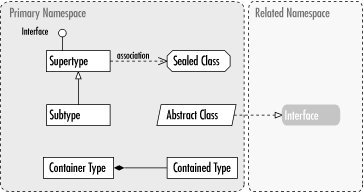Chapter 24. How to Use This Quick Reference
The quick-reference section that follows packs a lot of information into a small space. This introduction explains how to get the most out of that information. It describes how the quick reference is organized and how to read the individual quick-ref entries.
Finding a Quick-Reference Entry
The quick reference is organized into chapters, one per namespace. Each chapter begins with an overview of the namespace and includes a hierarchy diagram for the types (classes, interfaces, enumerations, delegates, and structs) in the namespace. Following the overview are quick-reference entries for all of the types in the namespace.
Figure 24-1 is a sample diagram showing the notation used in this book. This notation is similar to that used in Java in a Nutshell, but borrows some features from UML. Abstract classes are shown as a slanted rectangle, and sealed classes as an octagonal rectangle. Inheritance is shown as a solid line from the subtype, ending with a hollow triangle that points to the supertype. There are two notations that indicate interface implementation. The lollipop notation is used most of the time, since it is easier to read. In some cases, especially where many types implement a given interface, the shaded box notation with the dashed line is used.

Figure 24-1. Class hierarchy notation
Important relationships between types (associations) ...
Get C# in a Nutshell, Second Edition now with the O’Reilly learning platform.
O’Reilly members experience books, live events, courses curated by job role, and more from O’Reilly and nearly 200 top publishers.

